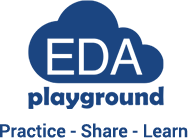This video will give you an overview of VMM 1.2, released in December 2009, highlighting the new features of VMM 1.2 and the overall conceptual framework.
SNUG Papers
Download the award winning SNUG 2010 paper, complete with presentation slides.
"Exploiting the TLM-2 Features of VMM 1.2"
Download the award winning SNUG 07 SystemVerilog paper, complete with presentation slides and tutor's notes.
"Creating Stimulus and Stimulating Creativity: Using the VMM Scenario Generator"
Full Edition of the VMM Golden Reference Guide
Further underlining our marketing leading credentials for the development and delivery of SystemVerilog training, Doulos published the full edition of the VMM Golden Reference Guide (GRG) at DVCon 2010. Check out the full range of Doulos Golden Reference Guides here.
The VMM Golden Reference Guide offers answers to the questions most often asked during the practical application of VMM in a convenient and concise reference format. This edition gives a comprehensive and fully updated guide to VMM 1.2, including the implicit phasing mechanisms and TLM-2-style communication. It also includes extensive information on the Register Abstraction Layer (RAL) VMM application.
The Golden Reference Guide is not intended to replace a proper training class, such as the UVM Adopter Class which covers VMM.
Further Information to Accompany the VMM Golden Reference Guide
We have developed a tutorial specifically to complement the content of the VMM Golden Reference Guide. You can find the tutorial here.
Observation in VMM and OVM
This short video explains the mechanisms for observing activity in VMM and OVM test benches for the purposes of checking and coverage collection.
Verification Methodology Manual for SystemVerilog
The Verification Methodology Manual for SystemVerilog is a professional book co-authored by verification experts from ARM Ltd. and Synopsys, Inc. and published by Springer Science and Business Media (ISBN 0-387-25538-9).
It describes a methodology suitable for verifying complex designs using SystemVerilog. It contains a wide-ranging set of rules and recommendations for constructing testbenches and test suites, for the use of assertions in verification, for making use of legacy testbench code and for system-wide verification strategy.
The building blocks of the methodology are a set of base classes which describe the important elements of a testbench:
- vmm_data for data objects and/or transactions
- vmm_xactor for the functional blocks of the testbench (transactors)
- vmm_channel (and related classes vmm_broadcast vmm_scheduler) for transactor communication
- vmm_log and vmm_notify for recording activity and inter-process communication
- vmm_atomic_gen and vmm_scenario_gen for stimulus generation
- vmm_env to describe the structure of a particular testbench





